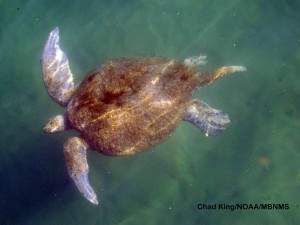
On November 7, 2011, a rare sighting of a Green sea turtle (Chelonia mydas) was made by MBNMS staff at the commercial wharf in Monterey, CA. Opportunistic photos and videos were captured by staff and sent to local sea turtle experts, whom positively identified it as a relatively old male Green sea turtle.
Green sea turtle sighting on YouTube
Green sea turtles are generally found south of San Diego, but in the eastern Pacific, have been sighted as far north as southern Alaska. This turtle was certainly outside of its normal range, and is considered a very rare sighting in Monterey, especially in such close proximity to shore and a public wharf.
The green turtle was listed under the Endangered Species Act on July 28, 1978. The breeding populations in Florida and the Pacific coast of Mexico are listed as endangered, and threatened elsewhere. In 2004, the International Union for Conservation of Nature (IUCN) listed the Green sea turtle as an endangered species, worldwide.
From NOAA Fisheries, Office of Protected Resources:
Green turtles are the largest of all the hard-shelled sea turtles, but have a comparatively small head.
Adult green turtles are unique among sea turtles in that they eat only plants; they are herbivorous, feeding primarily on seagrasses and algae. This diet is thought to give them greenish-colored fat, from which they take their name.
While nesting season varies from location to location, in the southeastern U.S., females generally nest in the summer between June and September; peak nesting occurs in June and July. During the nesting season, females nest at approximately two-week intervals. They lay an average of five nests, or “clutches.” In Florida, green turtle nests contain an average of 135 eggs, which will incubate for approximately 2 months before hatching.